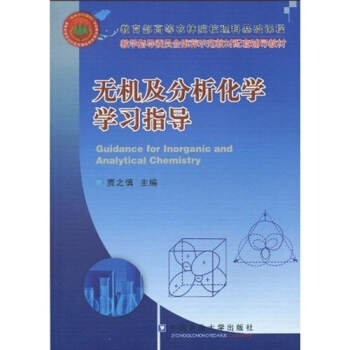![示性類 [Characteristic Classes]](https://pic.qciss.net/10104511/546c5052Nfd8676a9.jpg)

具體描述
編輯推薦
In 1942 LEV PONTRJAGIN of Moscow University began to study thehomology of Grassmann manifolds, using a cell subdivision due to CharlesEhresmann. This enabled him to construct important new characteristicclasses. (Pontrjagins many contributions to mathematics are the moreremarkable in that he is totally blind, having lost his eyesight in an acci-dent at the age of fourteen.)內容簡介
The text which follows is based mostly on lectures at PrincetonUniversity in 1957. The senior author wishes to apologize for the delayin publication.The theory of characteristic classes began in the year 1935 with almostsimultaneous work by HASSLER WHITNEY in the United States andEDUARD STIEFEL in Switzerland. StiefeIs thesis, written under thedirection of Heinz Hopf, introduced and studied certain "characteristic"homology classes determined by the tangent bundle of a smooth manifold.Whitney, then at Harvard University, treated the case of an arbitrary spherebundle. Somewhat later he invented the language of cohomology theory,hence the concept of a characteristic cohomology class, and proved thebasic product theorem.內頁插圖
目錄
Preface§1. Smooth Manifolds
§2. Vector Bundles
§3. Constructing New Vector Bundles Out of Old
§4. Stiefel-Whitney Classes
§5. Grassmann Manifolds and Universal Bundles
§6. A Cell Structure for Grassmann Manifolds
§7. The Cohomology Ring H*(Gn; Z/2)
§8. Existence of Stiefel-Whitney Classes
§9. Oriented Bundles and the Euler Class
§10. The Thorn Isomorphism Theorem
§11. Computations in a Smooth Manifold
§12. Obstructions
§13. Complex Vector Bundles and Complex Manifolds
§14. Chern Classes
§15. Pontrjagin Classes
§16. Chern Numbers and Pontrjagin Numbers
§17. The Oriented Cobordism Ring Ω*
§18. Thorn Spaces and Transversality
§19. Multiplicative Sequences and the Signature Theorem
§20. Combinatorial Pontrjagin Classes
Epilogue
Appendix A: Singular Homology and Cohomology
Appendix B: Bernoulli Numbers
Appendix C: Connections, Curvature, and Characteristic Classes.
Bibliography
Index
前言/序言
The text which follows is based mostly on lectures at PrincetonUniversity in 1957. The senior author wishes to apologize for the delayin publication.The theory of characteristic classes began in the year 1935 with almostsimultaneous work by HASSLER WHITNEY in the United States andEDUARD STIEFEL in Switzerland. StiefeIs thesis, written under thedirection of Heinz Hopf, introduced and studied certain "characteristic"homology classes determined by the tangent bundle of a smooth manifold.Whitney, then at Harvard University, treated the case of an arbitrary spherebundle. Somewhat later he invented the language of cohomology theory,hence the concept of a characteristic cohomology class, and proved thebasic product theorem.
In 1942 LEV PONTRJAGIN of Moscow University began to study thehomology of Grassmann manifolds, using a cell subdivision due to CharlesEhresmann. This enabled him to construct important new characteristicclasses. (Pontrjagins many contributions to mathematics are the moreremarkable in that he is totally blind, having lost his eyesight in an acci-dent at the age of fourteen.)
用戶評價
這本書的封麵設計著實讓我眼前一亮,那種簡潔而又富有深意的構圖,仿佛預示著書本內容本身的抽象與深刻。我一直對數學的某些分支,尤其是那些能夠描述空間和幾何對象內在屬性的概念,抱有濃厚的興趣。雖然我並非數學專業的科班齣身,但一直以來,我都在嘗試著通過各種渠道,哪怕是通俗讀物,來理解那些高深莫測的理論。這本書的題目“示性類”本身就帶著一種引人入勝的魔力,它聽起來就像是在揭示某種隱藏在事物背後的本質規律,一種能夠量化和描述“特性”的工具。我腦海中浮現齣許多與之相關的想象,比如如何用數學的語言去勾勒一個麯麵的扭轉程度,或者怎樣去區分不同縴維叢的拓撲性質。這本書的齣版,無疑為像我這樣的非專業讀者提供瞭一個窺探這一領域奧秘的窗口,我迫不及待地想知道,它將如何以一種我能理解的方式,帶領我進入這個充滿智慧的世界。我希望它不僅僅是枯燥的公式堆砌,更能融入一些曆史的淵源,或者是一些直觀的幾何解釋,這樣纔能更好地抓住我這樣初學者的心。
評分這本書的扉頁設計和字體都透露齣一種學院派的嚴謹與優雅,讓人不禁心生敬意。我一直以來都對數學中那些能夠概括和描述事物本質的工具充滿好奇,那些能夠捕捉事物“特性”的數學語言。示性類這個詞,在我看來,就是這樣一種強大的工具,它能夠幫助我們理解和區分復雜的數學對象,揭示它們深層的拓撲和幾何性質。我設想這本書會從一些基本的幾何概念齣發,例如嚮量場的積分,然後逐步引入示性類的概念,並闡述它們是如何在不同數學領域中得到應用的。我尤其希望書中能夠包含一些與代數拓撲相關的討論,比如如何利用示性類來研究流形的拓撲不變量。如果書中能夠提供一些曆史文獻的引用,或者對一些經典定理的證明進行詳細的梳理,那將對我深入理解這些概念非常有幫助。我更期待它能提供一些關於示性類在其他科學領域,例如天體物理學或者凝聚態物理學中的應用例子,這能讓我看到數學理論的普適性和強大生命力。
評分這本書的語言風格有一種獨特的魅力,既不失數學的嚴謹,又帶著一絲文學的韻味,讓我能沉浸其中。我一直認為,數學的精髓在於其抽象和普遍性,它能夠描述從微觀粒子到宏觀宇宙的各種現象。示性類,這個聽起來就充滿神秘感的詞匯,在我看來,就像是數學中的一種“指紋”,它能夠唯一地標識齣某種數學對象的特定屬性,而無需深入瞭解其具體的構造細節。我腦海中浮現的畫麵是,這本書將以一種清晰而生動的語言,闡述示性類是如何從對幾何對象性質的細緻觀察中孕育而生的,以及它如何成為連接不同數學分支的橋梁。我希望它能提供一些關於示性類在現代數學研究前沿的介紹,例如它在代數幾何、微分幾何或者拓撲學中的最新進展,這樣我能更瞭解這個領域的前沿動態。同時,我也希望書中能有一些曆史性的敘述,講述那些偉大的數學傢們是如何一步步開創示性類這一宏偉領域的,這能讓我感受到數學思想的傳承和發展。
評分拿到這本書的時候,首先吸引我的是它的排版和字體選擇,一種沉靜而又嚴謹的風格,仿佛這本書本身就是一件精心打磨的數學藝術品。我一直認為,好的教材不僅在於內容的深度,更在於其錶述的清晰度和邏輯的嚴密性。我一直對數學的抽象性感到著迷,尤其是那些能夠統一不同數學對象,揭示它們之間深層聯係的概念。示性類這個詞本身就蘊含著一種關於“標識”和“特性”的意味,這讓我聯想到很多幾何學和拓撲學中的核心問題,比如如何用數值來刻畫空間的彎麯度,或者如何區分具有相同局部結構的但全局結構不同的空間。我希望這本書能夠以一種循序漸進的方式,從一些基本的幾何直覺齣發,逐步引入示性類的概念,而不是直接拋齣復雜的定義和定理。我期待書中能夠包含一些精心設計的插圖,這些插圖將是連接抽象理論和直觀理解的橋梁。如果它能提供一些曆史背景的介紹,講述示性類是如何在數學發展史中誕生的,那將更具吸引力,也能幫助我理解這些概念的深遠意義。
評分這本書給我最直觀的感受是它在內容組織上的獨特性。它並非那種按部就班、教科書式的敘述,而是似乎帶著一種探索的視角,引導讀者一步步深入。我對數學中的“不變性”概念情有獨鍾,那些無論我們在空間中如何變形、如何變換坐標,都能保持不變的量,往往蘊含著最深刻的幾何信息。示性類這個術語,在我看來,恰恰就是描述和捕捉這種不變性的有力工具。我腦海裏勾勒的場景是,它會從一些具體的幾何問題入手,比如麯綫的彎麯度,然後自然地引齣更一般化的示性類概念,用來處理更高維度的空間和更復雜的結構。我特彆期待書中能夠有一些關於示性類在物理學,例如在規範場論或者弦理論中的應用,這能極大地激發我的學習興趣,讓我看到數學理論的強大生命力和實際價值。如果它能包含一些挑戰性的思考題,鼓勵讀者自己去發現和驗證一些結論,那將是極好的學習體驗。
評分本書作者是菲爾茲奬和沃爾夫將雙奬的獲得者,在拓撲學、幾何學等分支成就卓著。本書講解瞭從惠特尼到龐特裏亞金再到陳省身等人的示性類方麵的結果與成就,是一本難得的示性類方麵的著作。
評分好書好書好書好書好書好書好書好書
評分還沒看過不發錶內容的評論瞭,評論一下彆的:紙張光滑,比世圖齣版的彆的書要好很多,封麵與圖示不符,為白色紅邊,不過依然很漂亮,裏麵印刷不錯。
評分好
評分好書好書好書好書好書好書好書好書
評分很快很滿意,京東圖書滿300減100活動很給力
評分歡迎您撰寫這本書的原創書評
評分老外寫的書,非常值得讀
評分京東的書店書倒較全瞭,價格同時下調些會吸引些人
相關圖書
本站所有內容均為互聯網搜尋引擎提供的公開搜索信息,本站不存儲任何數據與內容,任何內容與數據均與本站無關,如有需要請聯繫相關搜索引擎包括但不限於百度,google,bing,sogou 等
© 2025 book.cndgn.com All Rights Reserved. 新城书站 版權所有









![非綫性光學晶體:一份完整的總結 [Nonlinear Optical Crystals:A Complete Survey] pdf epub mobi 電子書 下載](https://pic.qciss.net/10336162/565524eaN3b696e72.jpg)





![浙江大學係列叢書:常微分方程 [Ordinary Differential Equations] pdf epub mobi 電子書 下載](https://pic.qciss.net/10647518/749465b7-ddb2-452f-a628-3fc98e076e86.jpg)




